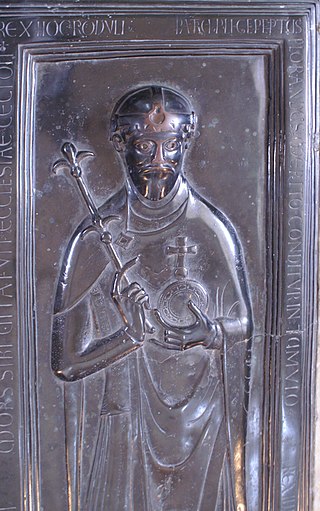Related Research Articles
The 1070s was a decade of the Julian Calendar which began on January 1, 1070, and ended on December 31, 1079.

Year 1080 (MLXXX) was a leap year starting on Wednesday of the Julian calendar.

Pope Gregory VII, born Hildebrand of Sovana, was head of the Catholic Church and ruler of the Papal States from 22 April 1073 to his death in 1085. He is venerated as a saint in the Catholic Church.

The Road to Canossa or Humiliation of Canossa, or, sometimes, the Walk to Canossa was the journeying to Canossa Castle in 1077 of the Holy Roman Emperor, Henry IV, and his subsequent ritual submission there to Pope Gregory VII. It took place during the Investiture controversy and involved the Emperor seeking absolution and the revocation of his excommunication by the Pope who had been staying at the castle as the guest of Margravine Matilda of Tuscany.

Rudolf of Rheinfelden was Duke of Swabia from 1057 to 1079. Initially a follower of his brother-in-law, the Salian emperor Henry IV, his election as German anti-king in 1077 marked the outbreak of the Great Saxon Revolt and the first phase of open conflict in the Investiture Controversy between Emperor and Papacy. After a series of armed conflicts, Rudolf succumbed to his injuries after his forces defeated Henry's in the Battle on the Elster.
Lambert of Hersfeld was a medieval chronicler. His work represents a major source for the history of the German kingdom of Henry IV and the incipient Investiture Controversy in the eleventh century.
Otto of Nordheim was Duke of Bavaria from 1061 until 1070. He was one of the leaders of the Saxon revolt of 1073–1075 and the Saxon revolt of 1077–1088 against King Henry IV of Germany.
Burchard of Basle, also known as Burkart of Fenis, Burchard of Hasenburg or Burchard of Asuel, was a Bishop of Basel in the eleventh century and a supporter of Holy Roman Emperor Henry IV (1056–1106).

The Diocese of Dresden–Meissen is a Latin Church diocese of Catholic Church in Germany with its seat in Dresden. It is suffragan to the Archdiocese of Berlin.
The Bishopric of Merseburg was an episcopal see on the eastern border of the medieval Duchy of Saxony with its centre in Merseburg, where Merseburg Cathedral was constructed. The see was founded in 967 by Emperor Otto I at the same time in the same manner as those of Meissen and Zeitz, all suffragan dioceses of the Archbishopric of Magdeburg as part of a plan to bind the adjacent Slavic ("Wendish") lands in the Saxon Eastern March beyond the Saale River more closely to the Holy Roman Empire.

Herman(n) of Salm, also known as Herman(n) of Luxembourg, the progenitor of the House of Salm, was Count of Salm and elected German anti-king from 1081 until his death.
Siegfried I was the Abbot of Fulda from 25 December 1058 until 6 January 1060, and from January 1060 until his death in February 1084, he was Archbishop of Mainz.

Bertha of Savoy, also called Bertha of Turin, was Queen of Germany from 1066 and Holy Roman Empress from 1084 until 1087 as the first wife of Emperor Henry IV.

Benno II was Bishop of Osnabrück from 1068 until his death. He served as a close advisor and architect of Emperor Henry IV. In 1080 he founded the Benedictine abbey of Iburg Castle.

The Saxon revolt was a civil war fought between 1077 and 1088, early in the history of the Holy Roman Empire. The revolt was led by a group of opportunistic German princes who elected as their figurehead the duke of Swabia, Rudolf of Rheinfeld, who became the anti-king. Rudolf was a two-way brother-in-law of the young King Henry IV of Germany, who had been crowned at the age of six and had taken the reins of power at age sixteen. The Great Revolt followed the Saxon Rebellion of 1073–75.

Otto I, traditionally known as Otto the Great, was East Frankish king from 936 and Holy Roman Emperor from 962 until his death in 973. He was the eldest son of Henry the Fowler and Matilda of Ringelheim.

Henry IV was Holy Roman Emperor from 1084 to 1105, King of Germany from 1054 to 1105, King of Italy and Burgundy from 1056 to 1105, and Duke of Bavaria from 1052 to 1054. He was the son of Henry III, Holy Roman Emperor—the second monarch of the Salian dynasty—and Agnes of Poitou. After his father's death on 5 October 1056, Henry was placed under his mother's guardianship. She made grants to German aristocrats to secure their support. Unlike her late husband, she could not control the election of the popes, thus the idea of the "liberty of the Church" strengthened during her rule. Taking advantage of her weakness, Archbishop Anno II of Cologne kidnapped Henry in April 1062. He administered Germany until Henry came of age in 1065.

Robert, also spelled Ruotbert or Rotbert, was the archbishop of Trier from 931 until his death. He played a leading role in the politics of both Germany and France, and especially of the Lotharingian territory in between. He was a patron of scholars and writers and a reformer of monasteries.
Tedald was archbishop of Milan from 1075 to 1085.
Werner of Steusslingen was the archbishop of Magdeburg from 1063 until his death. His episcopate was dominated by the Investiture Contest. He was an ally of King Henry IV of Germany until 1073, when he joined the first Saxon revolt. Imprisoned in 1075 and released the following year, he joined the second Saxon revolt in 1077. He was killed at the battle of Mellrichstadt.
References
- D.S. Bachrach and B.S. Bachrach, ‘Bruno of Merseburg and his historical method, c.1085,’ Journal of Medieval History, 40:4 (2014), 381-398.